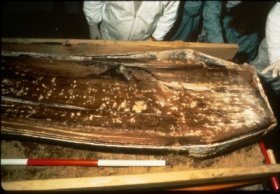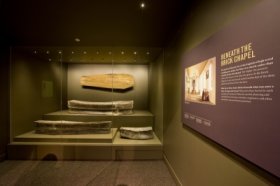Coffin Wood

Conservator’s Notes
Wood was an abundant resource and was used in many different ways during the 17th and 18th centuries. Wood was used to build houses, boats, fences, and for more personal items such as eating utensils, bowls, handles, furniture, and cabinets. Colonial craftsmen utilized different types of wood for different purposes based on its characteristics such as moisture content, flexibility, strength and size. Unfortunately, like many other organic materials, wood does not often survive in the archaeological record. It rapidly decays upon burial, and is quickly eaten away by biological and chemical activities. Archaeologists do know what wood was used for, however, based on historical and archaeological evidence. When an iron hoe is found in the ground, for example, we know that it must have been attached to a wood handle and this information gives us further clues into the uses of wood in 17th-century life.Wood can be remarkably well- preserved in a waterlogged environment. The lack of oxygen and the presence of water preserve this material if the conditions are just right. The water bonds with the cellulose in the wood, and enters the cell walls to hold the shape of the wood as it was buried. The lack of oxygen inhibits further damage by micro-organisms. Some surface damage may occur, but wood can survive hundreds of years in waterlogged conditions. Waterlogged conditions are found underwater and on land, where the soil or environment is saturated with water. Examples of waterlogged sites on land include wells, privies, land near the water table (riverside), marshland, and bogs. For more information visit the Project Lead Coffins web pages.
At HSMC wooden artifacts are rarely found. The water table is indeed high, but the ground is not saturated, and the water moves quickly underground exposing organics to micro-organisms, minerals, salts, oxygen and water. Thus, the wood quickly decays away. Having said that, on rare occasions a waterlogged environment may be created in a different way and wood has survived. This unique type of environment was found at Historic St. Mary’s City during a project in the 1990s called Project Lead Coffins — where three lead coffins were excavated from within the foundation of a brick chapel, and in each of the lead coffins the remains of the wooden coffin survived. The interior of the lead coffins were not entirely saturated with water, but they were very moist, they lacked oxygen and the lead provided a neutral environment. Inside each of the lead coffins survived a wooden coffin with the remains of the founders of Maryland. For more information visit the Project Lead Coffins web site.
When wood and other organic material is found wet upon excavation, it must be kept wet in order to retain its shape, morphology, size and information. The wood coffins at HSMC were quickly transported to containers of water so they could be further examined and decisions about their treatment could be determined. For further information on the assessment and decisions of treating waterlogged wood, please see the Conservation FAQ at the Society for Historical Archaeology web site.
In the field, each of the wooden coffins was examined, recorded and transported to the laboratory for further cleaning, analysis and treatment. All three coffins were in numerous pieces, several of which were larger than others. The wood remained structurally sound, intact and was partially saturated with water. Specialized tanks were built to hold the coffins in water throughout the treatment process, and the wood was quickly put into de-ionized water to start removing the dirt and salts from the wood cells. The coffins soaked in changes of de-ionized water for several weeks before they could be immersed in a treatment solution.
Polyethylene Glycol (PEG), an inert, stable wax preservative, was chosen to treat the coffins. This liquid wax was slowly added to the water baths over the next six to twelve months, and the water and wax slowly moved into the wood cells, replacing the free water with the PEG mixture. When this treatment step was finished, the wood was ready for removal from the solution of PEG and water.

In order to remove any excess water from the wood, and to dry the wood with minimal shrinkage to the cell walls, the wood needed to be vacuum freeze dried. The process of vacuum freeze drying has been well researched for the drying of archaeological waterlogged organics. The process involved freezing the wood in a domestic freezer, prior to freeze drying, to remove the remaining water in the wood structure. The wood was then put into a freeze dryer where a vacuum is drawn and the water was forced to gently leave the wood slowly and evenly. The water was taken from a frozen state to a gaseous state (called sublimation) without returning to liquid, and was displaced from the wood through the freeze dryer. This process can take between one to four months depending on the size and thickness of the wood. The wood was weighed periodically throughout the process until the weight of the wood plateaus and little to no additional water can be removed.
Once the wood has reached an equilibrium the wood is removed from the freeze dryer and air dried. The surfaces can then be cleaned and any excess PEG is then removed. Freeze drying wood prevents cracking, shrinkage and color saturation of the wood post treatment. Wood that is freeze dried is still fragile and may be slightly heavier than normal due to the presence of the wax in the wood structure
Curator’s Notes
Preservation of wood in archaeological sites in St. Mary’s City is a rare occurrence. Wood represented one of the most commonly used materials in colonial life, but since it decays in the ground it is seldom recovered in excavations. This phenomenon, known as differential preservation, effects what archaeology can tell us about the past and points out the value of documentary research which can fill in many of the holes left by artifacts which rot away in the ground.
 The wood lid of the coffin was preserved because of the toxic nature of lead which retards biological activity. It allowed for unique preservation. Another reason why the wood preserved was the species of tree the colonists chose for the lid. The wood represents Atlantic White cedar (Chamaecyparis thyoides), a very rot resistant species.
The wood lid of the coffin was preserved because of the toxic nature of lead which retards biological activity. It allowed for unique preservation. Another reason why the wood preserved was the species of tree the colonists chose for the lid. The wood represents Atlantic White cedar (Chamaecyparis thyoides), a very rot resistant species.
The wooden lid, along with the three lead coffins are on display at the Smithsonian Museum of Natural History.


